The Ascent is Neon Giant’s first game, and it’s hugely impressive
- Developer: Neon Giant
- Publisher: Curve Digital
- Release date: 29th July 2021
- Genre: Action-Shooter RPG
- Platforms: Xbox One/X/S, Series X|S, PC (Steam, Windows 10)
- Reviewed on: Xbox Series X and S
- Game Supplied by: Publisher

The Ascent Xbox Series X|S Review
Sir Alec Issigonis, the designer of the original Mini, coined the saying, “A camel is a horse designed by a committee.” It suggests that the more people there are involved in the decision-making and design of something, the more fragmented and diluted the original vision becomes.
The development team behind The Ascent are the antithesis of this phrase. Comprised of just twelve developers, each with a background in AAA game development, they have proven that you don’t need a huge team with an astronomical budget to make a fantastic game – All it takes is a small but dedicated team with a singular vision.
Throughout development they had a simple process when deciding what to add to the game:
– Hey, I have a really cool idea!
– Sounds good, can you create it yourself?
– Yeah!
– Ok, go for it!
With a team this talented and experienced, this has led to a game that’s supremely well focused, crammed full of creativity, unique ideas and quality of life additions. The Ascent is truly a standout title that can hold its own amongst the greats of the genre.
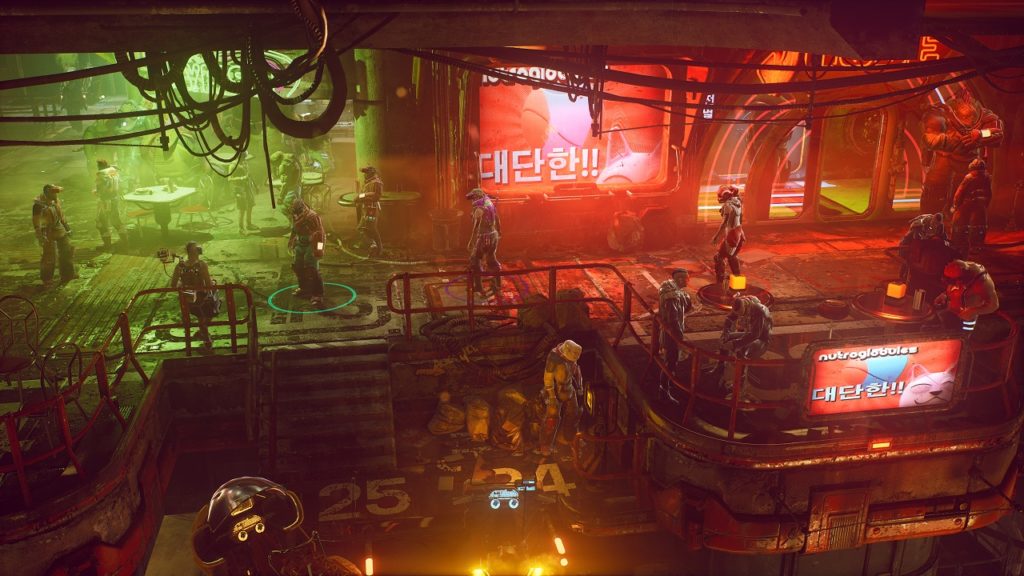
You belong to the corporation. Can you survive without it?
You start your journey as an Indent, an indentured servant to the Ascent Group. You, and many others, headed to Veles to start a new life, only to be saddled with debt and forced into a life of servitude as you try to earn enough creds to pay off the corporation. One day, for reasons unknown, the Ascent Group shuts down, and you become embroiled in a brilliant sci-fi story filled with mystery, power struggles and betrayal.
If you’ve seen the trailer, it’s easy to assume The Ascent is all about running and gunning with little substance, but it is far, far more than that. The Ascent has a gripping narrative, fleshed out with some excellent world-building and huge amounts of lore, main quests to complete and an abundance of interesting side quests to discover.
When you begin the game, you are equipped only with a basic pistol and some armour that’s about as effective as trying to stop a bullet with a piece of paper. It doesn’t take long before The Ascent starts giving you new loot to collect and upgrade, though, and soon you will be armed to the teeth with a massive array of weaponry, armour and abilities at your disposal.
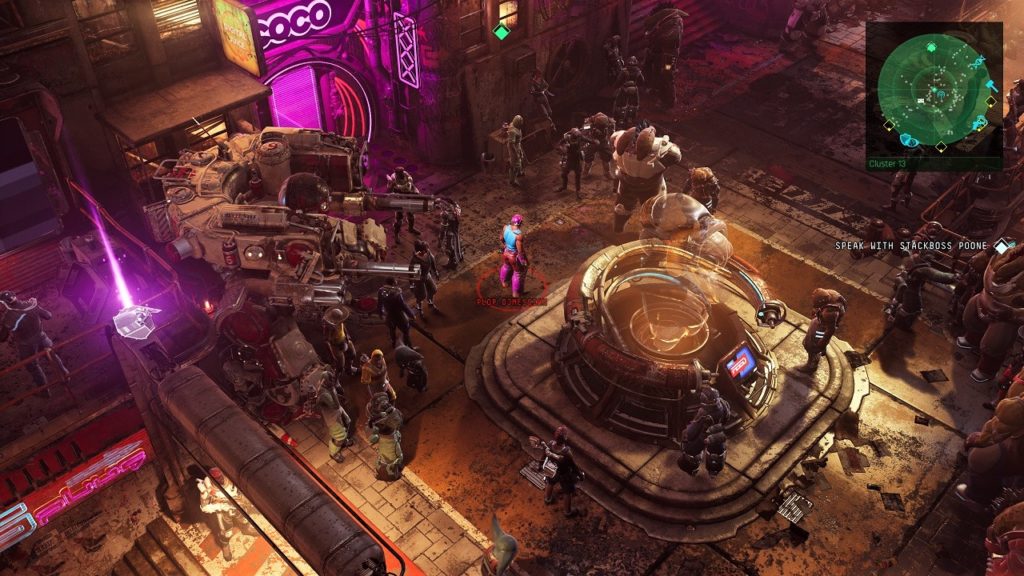
We’re going to need guns. Lots of guns.
There’s a great variety of weapons, which can all be upgraded with components found in loot drops or through exploration. All of the weapons feel punchy and powerful, and there’s something to suit any playstyle. For me, I preferred automatic weapons as they are highly effective against swarms of enemies, which is very useful if you are playing solo! For my secondary, I either carried an energy weapon to deal additional damage to robotic enemies, or a high-powered shotgun or heavy weapon to deal with boss fights and tougher enemies.
Once upgraded, any future duplicates of that weapon will have the same upgrades pre-applied. Although this does help keep weapons viable further into the game, once you level up past a certain point it does restrict experimentation with new weapons a little, as some need a lot of hard to find upgrade components to become effective. That said, many late-game weapons start with superior DPS stats, and I found I frequently changed my loadout when discovering new firepower.
Something I appreciated is that you don’t need to find ammo, as you have an infinite supply, so no panicking and trying to swap your loadout mid-battle. Similarly, tactical equipment deployment (turrets, grenades and other explosives fall under that category) is unlimited, recharged by damaging enemies; augmentations are also unlimited but with a mandatory cooldown, and like health and other abilities, their effectiveness is governed by your attributes.
After what feels like an eternity of games that need you to find dozens of different resources for every aspect of your equipment, The Ascent has managed to streamline the process without ever feeling like it has dumbed itself down.
Yeah, I got skills. What you gonna do about it?
In true RPG fashion, every time you level up, you gain a few skill points to assign to your chosen area. At first, I pumped a load into evasion and health as you are a bit squishy when you start off. As you progress, though, and have access to more augs and get to grips with the gameplay, you can start experimenting with your build a bit more. It’s possible to reassign skills at any point, but the more you have, the more credits it costs, so it’s best to choose wisely.
This flexibility opens up plenty of opportunities for creating your own unique build. Although there are no specific classes available, if you play The Ascent in co-op, you can spec your character as a tank, healer or DPS dealing death machine without too much trouble, though the variants won’t be quite as specialised as those in an MMORPG.
There was no one available for me to join during the review phase, but games like this are always better in co-op. It’s brilliant playing solo, so I can’t wait to dip my toes into online when it becomes available (up to four players can party up online, but The Ascent can also be played in couch co-op with four players, too).

“Cover-based shooting and run-and-gun mayhem”
Combat encounters are frequent, and occasionally very challenging. There were a few battles that took me a good six or seven tries to get past, but they never felt unfair, just hard. Thanks to a robust autosave system and generous checkpoints before harder battles, it’s a breeze to switch your loadout and try new tactics, or just get back into the fray and try to dispatch enemies more efficiently. The sense of satisfaction you get from beating these encounters is palpable.
Combat is an awesome mixture of cover-based shooting and run-and-gun mayhem. Mastering both methods is essential, as you constantly face off against melee attackers and gun-wielding adversaries. When crouched behind some cover you can’t be hit through the cover, but you can raise your gun and shoot people over the top of it. Stay in cover too long, though, and melee attackers will swarm you, dealing massive damage, so you’ll have to switch tactics frequently.
These varied ways of approaching encounters mean you are always paying attention to your environment, ascertaining the most dangerous threat and constantly looking for an opportunity to get the upper hand. It’s far more satisfying than a typical twin-stick shooter, which often boils down to backpedalling with a chain of enemies circling behind you. It’s made all the better by a rich and varied number of enemy types, with loads of heavy weapons, tactical equipment and augs of their own.
You don’t have replenishing health, although there are a few Augs and pieces of tactical equipment you can use if you get in a jam. Enemies frequently drop health packs, so you’ll have to decide whether it’s worth risking jumping out of cover to grab them or hope you can survive the wave of enemies, which adds another layer of tactical depth. Outside of combat they can be purchased from vending machines around the map or found in crates, and once your ICE is levelled up enough, you can just hack the machines for free health (although I was well into the game before I realised this – d’oh!)
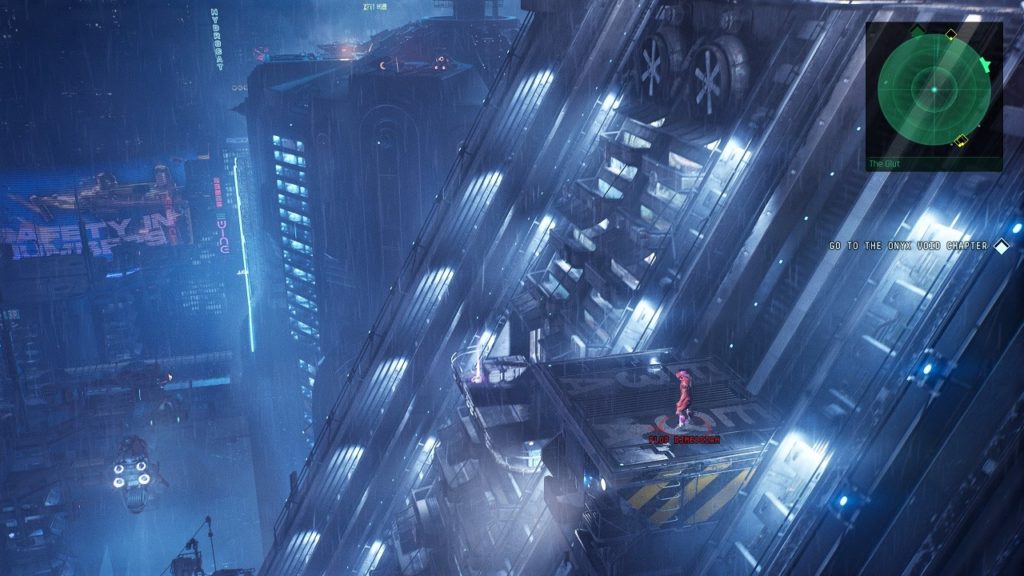
Blade Runner Umbrellas!
The Ascent has atmosphere by the bucketload. It is a stunningly good-looking game, which has clearly taken inspiration from dystopian sci-fi movies – they even have those awesome light-up umbrellas like in Blade Runner! It runs at a super-smooth 4k 60fps on the Series X and 1440p 60fps on the Series S, and I didn’t spot any significant frame drops on those consoles.
The Ascent is easily one of the best games I’ve seen when it comes to creating an authentic and believably densely populated city. The environments are jam-packed with detail, and every locale has been filled with unique design flourishes that make Veles look like a living, breathing city. Neon lighting soaks the streets, which are crammed with dozens and dozens of NPCs going about their business.
Considering it has an almost isometric viewpoint it would have been easy for the developers to skimp on the detail, especially as a lot of it is so small as to go unnoticed, but they have gone above and beyond. There is no obvious trace of assets being copy and pasted; every room, alleyway, building and street looks bespoke.
It’s not just the graphics and gameplay that are a labour of love, the sound design is impeccable, too. A gritty sci-fi soundtrack follows you around, ramping up in intensity as you enter combat. Weapons have a visceral impact as you unleash a hail of bullets, and it helps give The Ascent an intensity and urgency often missing from games.
The incidental and ambient audio is excellent, too. From the sounds of spaceships whooshing past to the hubbub of the busy city streets, it all helps bring a level of immersion to The Ascent that elevates it to the next level.
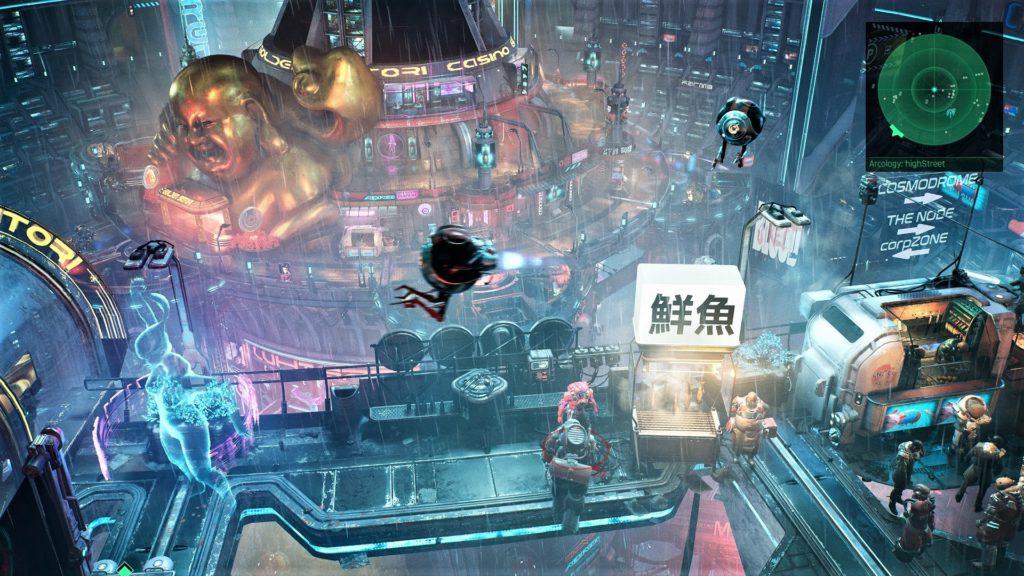
Player focused design
As I mentioned earlier, The Ascent has been made with the player in mind. Whether it’s the excellent auto-save and sensible checkpoints, the supremely satisfying combat or the convenient route overlay you can bring up, you can tell Neon Giant want this game to be enjoyable in every way. The city itself is huge, but it is easy to navigate thanks to the free-to-use train system, or you can even summon a taxi from almost anywhere in the world (it does cost 1000 creds, though, which is quite a bit).
There are so many more quality of life additions and so much more that I’ve enjoyed that I’d love to ramble on about, such as the often dark humour that is ever-present, but I’m painfully aware that writing this review is stopping me from jumping back into The Ascent. The fact this game has me itching this badly to get back to playing it is a testament to how well the loot, progression and rewards system has been implemented; It’s deliciously addictive!
It’s easy to draw comparisons to the likes of Diablo, and it does share some common features, but The Ascent is a masterpiece in its own right. This may be Neon Giant’s first IP, but they’ve entered the fray with a remarkably good game. As far as statements of intent go, this is a big one. If twelve people can make a game this innovative and polished, and sell it for such a cheap price, then some of the bigger devs need to get their finger out.
During my playthrough I did encounter a couple of minor glitches: Mission waypoints led me to dead ends or didn’t appear in the correct place a couple of times, but restarting the game fixed it for me; some audio effects were sounding in unusual places (stuttering spacecraft sounds indoors); the audio balance was a little off during one of the boss battles. These will likely be fixed in the day one patch, and they certainly weren’t game-breaking. Considering the scope of the game and the small team, that this is the worst I can say about The Ascent speaks volumes.
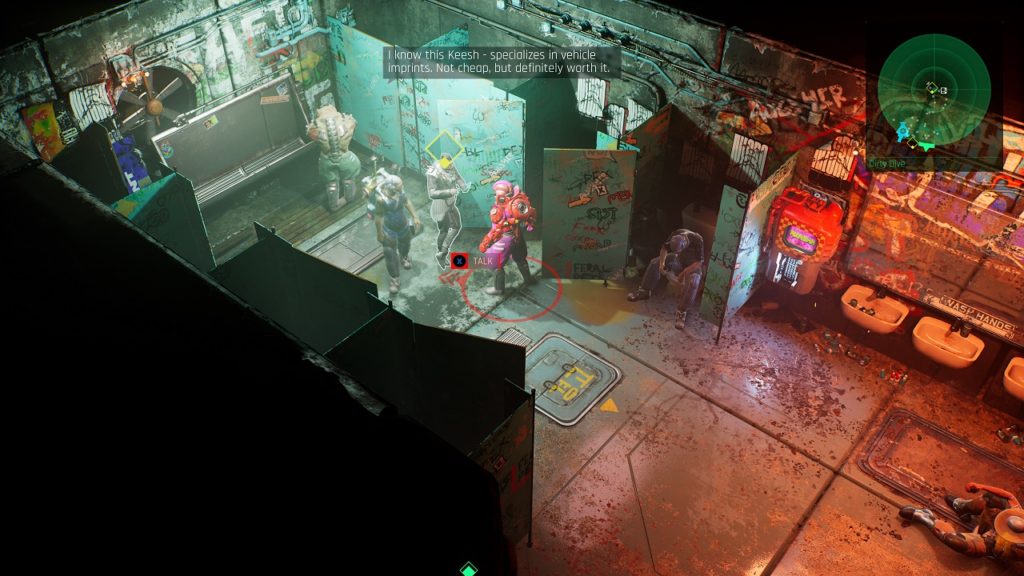
Summary
The Ascent is a tour de force from developer Neon Giant. The core gameplay mechanics are perfectly implemented with incredibly satisfying combat, accompanied by a fantastic story and numerous very welcome quality of life features. Its difficulty is just on the right side of challenging, and there is just the right amount of depth to its RPG underpinnings to satisfy more hardcore gamers without alienating newcomers. The Ascent is definitely a must-play title.
(The Ascent is available from day one on Xbox Game Pass or can be purchased on Xbox consoles, Xbox for Windows 10 and Steam, costing £24.99/$29.99/€29.99 (crossplay is not available on Steam.))

